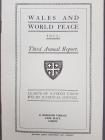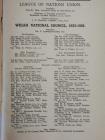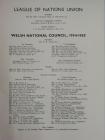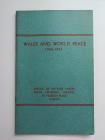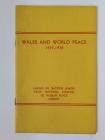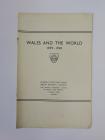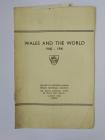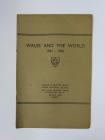Annual Reports of the Welsh League of Nations Union (1922-1943).
Collection description:
This collection contains the annual reports of the Welsh League of Nations Union. It includes every annual report produced by the movement between 1922-1943. The physical copies of these reports are housed at the Temple of Peace and Health (Cardiff, Wales). They have been digitised by the Welsh Centre for International Affairs to mark the end of the ‘Wales for Peace’ project.
This resource can be used to learn about the Welsh League of Nations Union. It can also be used to discover how Wales interacted with the international world and how the international world understood Wales. Although these reports do not present the entire story of the League of Nations in Wales, they act as a fantastic summary.
A caption has been constructed to accompany each report. These provide a brief summary of what can be found in the report. In places, information is supplied that places the report into the wider context.
Annual report information:
The period covered by the reports began at the start of the formal establishment of the Welsh League of Nations Union (see below section entitled ‘context to the Welsh League of Nations Union’ for more information). The yearly review began in Whitsuntide of the one year to the Whitsuntide of the next. However, the financial sheets (often found towards the end of each report), would be dated the last day of each year. This was due to how the Finance Committee recorded its finances.
It is unclear which individuals acquired the responsibility of constructing the annual reports. However, they were endorsed by the Executive Committee (those responsible for running the Welsh League of Nations Union). For editions in the 1930s, Rev. Gwilym Davies produced write ups of certain sections that included a summary of international events and the details of the Goodwill Message of the Children of Wales.
The annual reports showed how Wales promoted the league at a local, national and international level. A regular feature was the discussion of branches, membership and events used to advertise the League. The work of the Welsh Advisory Education Committee regularly featured in the annual reports. This illustrated how the Welsh League of Nations Union was working to promote international education and the teaching of ‘World Citizenship’. Resolutions adopted by the Welsh League of Nations Union in response to international events were a regular feature in the annual reports.
Context to the Welsh League of Nations Union:
In 1920, upon the ratification of the Treaty of Versailles, the League of Nations officially came into existence. The idea of the League was discussed long before the 1918 armistice. The Paris Peace conference developed the idea of the League into a reality. It acquired the responsibility of maintaining world peace through promoting co-operation and the use of arbitration to settle disputes. Member states were required to come together to challenge acts of aggression by a belligerent nation. Other areas of its work included global health, the protection of minorities in Europe and human trafficking.
However, the League’s impact extended beyond governments and international delegates. The League inspired a vibrant culture of social activism and political protest. Millions around the world invested their faith into the League to maintain peace. Dozens of societies emerged within Europe, and around the world, that engaged with the principles put forward by the League. Although varying in size, these movements were vibrant networks that worked tirelessly to promote the League and internationalism.
Following the Armistice in 1918, the League of Nations Society and the League of Free Nations Association (two movements that favored the concept of the League during the First World War) joined together to create the British League of Nations Union. Initially the work of Wales was conducted under the umbrella of the British model. Welsh branches paid subscription to the British movement.
A Welsh League of Nations movement took time to develop. The 1918 Neath Eisteddfod was the first time creating a Welsh movement was discussed with purpose. In May 1920, a meeting at Llandrindod Wells resulted in the creation of an Executive Committee. Their responsibility was to control League related activities until a permanent Welsh National Council could be formed. In January 1922, increased support of Welsh movement was met with a financial donation by Lord David Davies of Llandinam. The result was the establishment of the Welsh National Council of the League of Nations Union. Its first Annual Conference was held at Llandrindod Wells during the Easter of 1922. At this conference, it was decided that the Welsh League of Nations Union would gain self-governance in matters of the League that affected Wales and Monmouthshire. It became financially and administratively independent to the British movement. It took responsibility for the organisation of branches and deciding on how to implement internationalism onto society. Despite this independence, both the Welsh and British movements continued to co-operate with each other at various points of the interwar years in order to strengthen the League’s position in society.


